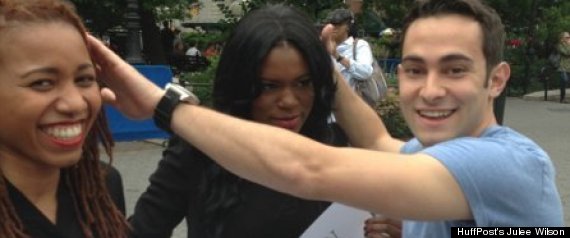
On Thursday, the dichotomies between exploitation and admiration were challenged in an art exhibit titled "You Can Touch My Hair."
Antonia Opiah, founder of un-ruly.com, a site dedicated to black hair, held the interactive exhibit in the heart of New York City, encouraging strangers to touch black female participants' hair.
To some, the art exhibit mirrored characteristics of the "human zoo," a phenomenon that emerged in the 1800s that capitalized on the exploitation of groups of people who were considered exotic.
In the mid 1800s, the "Other"-- a subject considered separate from an established, conventional group -- was put on display in a series of human zoo exhibitions in European societies.
Similar to the human zoo, the "You Can Touch My Hair" exhibit featured a group of people possessing an "exotic" characteristic for spectators to examine. Black women were, quite literally, put on display to observe and touch, with respect to their hair.
People expressed immense aversion to the concept of strangers intruding personal space to touch hair. However, Thursday's exhibit contributed to an ongoing conversation exploring why something as biologically banal as hair is transcended into a racial, political and social issue.
Does asking to touch make you exploitive? Does condoning the touch make you a participant in your own exploitation? Is the modern display of black women problematic?
Opiah defended the exhibit on Thursday, affirming it welcomed discussion and it was easy to disapprove of something so literal.
"I'm seeing a sense of discomfort and disapproval of the exhibit, which is exactly what I hoped would come to the surface," Opiah said.
The thin line between what is considered admiration or objectification can be measured in context. The earliest human zoos did not place the other in a position of power or authority on their own culture. The vessel of information was limited to ogling a human being for his or her exotic Otherness, ultimately dehumanizing someone for the sake of entertainment.
One of the most egregious examples of the human zoo would be the exhibit of Saartjie Baartman, a South African displayed throughout Europe as a sex object in the early 1800s. According to BBC News, Baartman, later referred to as "Hottentot Venus," had a genetic characteristic known as "steatopygia" -- exceptionally large buttocks with an elongated labia. After she died, her remains were reportedly put on display until 1974.
In the "You Can Touch My Hair" exhibit, the Others, black female participants, consent to the ogling in hopes of deconstructing the curiosity for mutual education. The exhibit and the exhibited are forced to confront each other's questions about race.
Though the intent of this unorthodox social experiment encourages progressive conversations about race, participants are left interpreting whether or not the Other is redeemed. While the ongoing scrutiny of black hair is brought forth, people of color must decide whether participating in the display is a celebration of black hair or an extension of the very exploitation we try to deconstruct.
Do you think people taking it upon themselves to touch your hair is celebratory or dehumanizing? Continue the conversation in the comments below.
